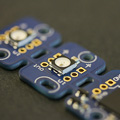Overview of the UWP library
 Several customers have tried to use our C++ or C# libraries with Windows 10 IoT on a Raspberry Pi. Unfortunately, this doesn't work because Windows 10 IoT is not a "true" Windows: it doesn't allow you to run Win32 applications. You can run only the new universal applications. We are currently working on a solution which would allow you to use our modules on all the Windows 10 versions, including Windows IoT. This post gives us the opportunity to review the matter...
Several customers have tried to use our C++ or C# libraries with Windows 10 IoT on a Raspberry Pi. Unfortunately, this doesn't work because Windows 10 IoT is not a "true" Windows: it doesn't allow you to run Win32 applications. You can run only the new universal applications. We are currently working on a solution which would allow you to use our modules on all the Windows 10 versions, including Windows IoT. This post gives us the opportunity to review the matter...
| No comment yet | Read more... |
New: the Yocto-3D-V2
 The Yocto-3D is in the top 10 of the products we sell the most. Nevertheless, we have a problem with it: it doesn't allow us to calibrate a compensation for magnetic perturbations, and its firmware is choke-full, which prevents us from improving it. So we attacked the problem from a different angle and, today, we propose a new, similar product, but based on a more efficient sensor including hard iron magnetic compensation. Welcome to the Yocto-3D-V2...
The Yocto-3D is in the top 10 of the products we sell the most. Nevertheless, we have a problem with it: it doesn't allow us to calibrate a compensation for magnetic perturbations, and its firmware is choke-full, which prevents us from improving it. So we attacked the problem from a different angle and, today, we propose a new, similar product, but based on a more efficient sensor including hard iron magnetic compensation. Welcome to the Yocto-3D-V2...
| No comment yet | Read more... |
Animating RGB LEDs using a Yocto-Color-V2
 When we announced the Yocto-Color-V2, we explained that this new version can drive up to 146 NeoPixel leds. However, to use this new feature, you must use a new API that we are going to discover in this post.
When we announced the Yocto-Color-V2, we explained that this new version can drive up to 146 NeoPixel leds. However, to use this new feature, you must use a new API that we are going to discover in this post.
| No comment yet | Read more... |
Sending and receiving SMS from a software
![]() We have just added a new feature to the YoctoHub-GSM. If you update your firmware, you will be able to use it to send and receive SMS. This is might not look very useful to access a Yoctopuce sensor, but it opens the door to new use-cases for the YoctoHub-GSM itself. For instance, you can now implement two factor authentication.
We have just added a new feature to the YoctoHub-GSM. If you update your firmware, you will be able to use it to send and receive SMS. This is might not look very useful to access a Yoctopuce sensor, but it opens the door to new use-cases for the YoctoHub-GSM itself. For instance, you can now implement two factor authentication.
| No comment yet | Read more... |
New! The Yocto-Color-V2
![]() This week, we invite you to meet a newcomer: the Yocto-Color-V2. Basically, it's a multicolor led driver designed to replace the Yocto-Color. Wait! Don't go just yet! This module can do much more than drive two RGB leds. You can do some real cool stuff with it...
This week, we invite you to meet a newcomer: the Yocto-Color-V2. Basically, it's a multicolor led driver designed to replace the Yocto-Color. Wait! Don't go just yet! This module can do much more than drive two RGB leds. You can do some real cool stuff with it...
| No comment yet | Read more... |


